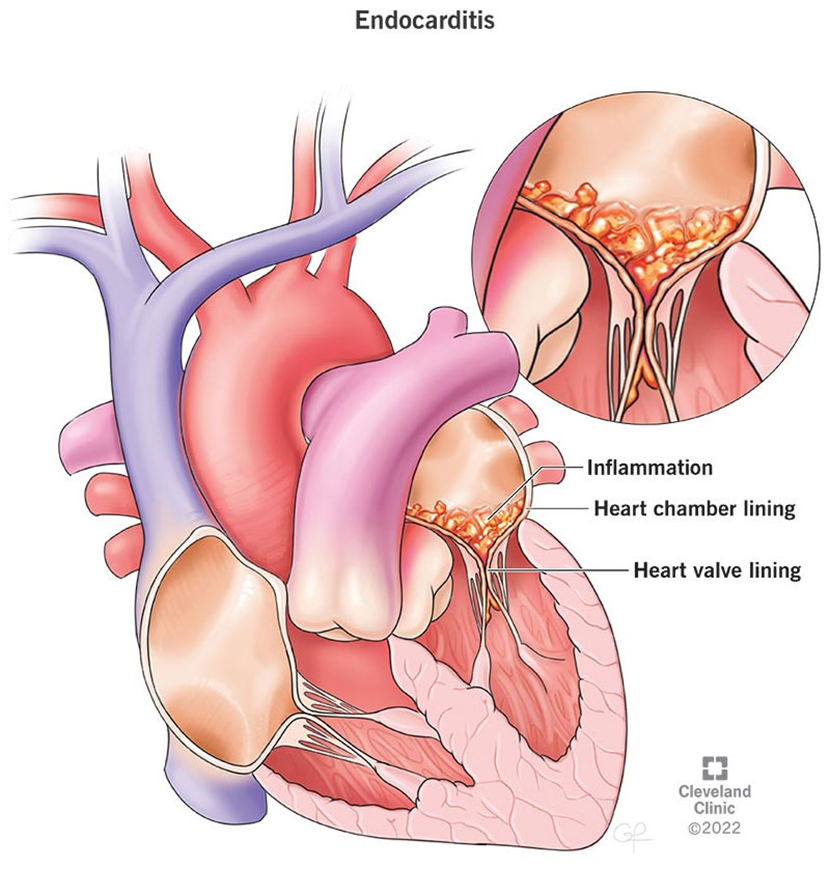Which of the following is a complicated manifestation of infective endocarditis?
Reduced blood pressure
Osler's nodes
Clear lung sound
Increased appetite
The Correct Answer is B
Choice A Reason:
Reduced blood pressure is not a specific complication of infective endocarditis. While hypotension can occur in severe cases due to septic shock, it is not a hallmark of the disease. Infective endocarditis primarily affects the heart valves and can lead to embolic events, heart failure, and other complications.
Choice B Reason:
Osler's nodes are a classic sign of infective endocarditis. These are painful, red or purple, raised lesions found on the hands and feet. They are caused by immune complex deposition and are indicative of the systemic nature of the infection. Their presence can help in the clinical diagnosis of infective endocarditis.
Choice C Reason:
Clear lung sounds are not a complication of infective endocarditis. In fact, clear lung sounds would generally indicate that there is no pulmonary involvement or congestion. Complications of infective endocarditis are more likely to involve the heart, kidneys, and other organs through embolic events.
Choice D Reason:
Increased appetite is not associated with infective endocarditis. Patients with this condition often experience symptoms such as fever, fatigue, and weight loss due to the chronic infection. Increased appetite would be an unusual finding and not related to the disease process.

Nursing Test Bank
Naxlex Comprehensive Predictor Exams
Related Questions
Correct Answer is B
Explanation
Choice A Reason:
0.9% sodium chloride is an isotonic crystalloid solution often used for fluid resuscitation. However, it is not the preferred choice for burn patients because it lacks the necessary electrolytes to replace those lost through burn injuries. While it can be used if Lactated Ringer's is unavailable, it does not provide the same balanced electrolyte composition.
Choice B Reason:
Lactated Ringer's is the preferred fluid for initial resuscitation in burn patients. It is an isotonic crystalloid solution that closely mimics the body's plasma, providing essential electrolytes such as sodium, potassium, calcium, and lactate. The lactate in the solution acts as a buffer, helping to correct metabolic acidosis, which is common in burn patients. The Parkland formula, widely used for calculating fluid needs in burn patients, specifically recommends Lactated Ringer's for the first 24 hours.
Choice C Reason:
Dextrose 5% in water is a hypotonic solution that provides free water and calories but lacks electrolytes. It is not suitable for initial fluid resuscitation in burn patients because it does not address the electrolyte imbalances and large fluid shifts that occur after a burn injury. Using this solution could lead to further complications such as hyponatremia.
Choice D Reason:
Dextrose 5% in 0.9% sodium chloride is a hypertonic solution that provides both glucose and electrolytes. However, it is not typically used for initial burn resuscitation because the high glucose content can lead to hyperglycemia, which is detrimental to burn patients. Additionally, the solution's osmolarity can exacerbate fluid shifts and worsen edema.
Correct Answer is ["20.46"]
Explanation
Step 1: Convert the client's weight from pounds to kilograms.
150 pounds ÷ 2.2 = 68.18 kg
Result at each step = 68.18 kg
Step 2: Calculate the dose in mcg/min.
3 mcg/kg/min × 68.18 kg = 204.54 mcg/min
Result at each step = 204.54 mcg/min
Step 3: Convert the dose from mcg to mg.
204.54 mcg ÷ 1000 = 0.20454 mg/min
Result at each step = 0.20454 mg/min
Step 4: Calculate the infusion rate in mL/min.
0.20454 mg/min ÷ 600 mg × 1000 mL = 0.341 mL/min
Result at each step = 0.341 mL/min
Step 5: Convert the infusion rate to mL/hour.
0.341 mL/min × 60 min/hour = 20.46 mL/hour
Result at each step = 20.46 mL/hour
So, the infusion rate is 20.46 mL/hour.
Whether you are a student looking to ace your exams or a practicing nurse seeking to enhance your expertise , our nursing education contents will empower you with the confidence and competence to make a difference in the lives of patients and become a respected leader in the healthcare field.
Visit Naxlex, invest in your future and unlock endless possibilities with our unparalleled nursing education contents today
Report Wrong Answer on the Current Question
Do you disagree with the answer? If yes, what is your expected answer? Explain.
Kindly be descriptive with the issue you are facing.
